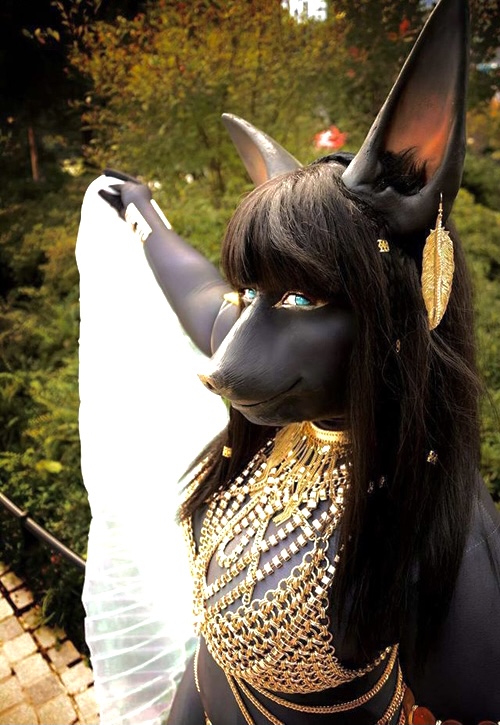Image Attribution: “IMAGE OF COSPLAY CHARACTER ANPUT GODDESS” by Raluchukwu Ojah is licensed under a different open license (). (See interactive map)
Ojah Raluchukwu.
T00684460.
Terryl Atkins
VISA 1500 Oct 2021
Assignment 2 Part A
CRITICAL ANALYSIS.
IMAGE OF COSPLAY CHARACTER ANPUT GODDESS
The image above is an original cosplay design of MewPuff of MewPuff and MiniPuff CosSlay, a cosplay and prosthetic model/designer dressed as Anput the ancient Egyptian goddess of Embalming and purification, the counterpart of the god Anubis and also the seventeenth nome of Upper Egypt. The picture was taken during a Cosplay/Prosthetic application cast by Photographer Dapper Moose on December 22, 2017.
The ancient Egyptians believed in the afterlife and their attitude towards death was influenced by their belief in immortality. To ensure their continuity to the afterlife, people paid homages to the gods, both during and after their life on earth. When they died, they were mummified so the soul would return to the body.
Anput goddess was the counterpart of the god Anubis, a jack-headed deity who presided over the embalming process and accompanied dead kings in the afterlife. The goddess Anput was often depicted as a pregnant or nursing jackal, or as a jackal wielding knives.
In the above picture, she is depicted as a woman with the head of a jackal which is rare. This is because the goddess Anput is also recognized as the goddess of purification where bodies were taken to the tent known as ‘ibu’or the place of purification where embalmed with sweet-smelling palm wine would be later rinsed with water from the Nile. She was also a protector over the body of the god Osiris.
Embalming has become a restorative art, men and women have practiced human preservative methods and restoration art to restore and maintain bodies free from decomposition and return the body to its natural lifelike appearance. The ancient Egyptians practiced their embalming and mummification techniques to meet religious goals involving the afterlife. In more recent times, the practice was a matter of necessity; the early study of anatomy and the technique of dissection helping to preserve corpses to be studied for longer periods in any weather.
The model believed that dressed as the goddess Anput gave a boost to her strengths as a woman making her feel powerful while crafting out the design for the costume. Being a model and also a cosplay designer gives her the chance to explore her gifts and ideas. The image depicts the goddess Anput and also sends a powerful message across.
References:
- Wikipedia, https://en.wikipedia.org/wiki/Anput
- Elite Staff, (History of embalming and restorative arts) (https://s3.amazonaws.com/EliteCME_WebSite_2013/f/pdf/FTX03HEI15.pdf)
- Pettigrew, Thomas J . Observations on the Practice of Embalming among the Ancient Egyptians, Illustrated by the Unrolling of a Mummy from Theb
- Mayer, Robert G, Embalming History, Theory, and Practice, McGŠ Strub, C.G., and L.G. Frederick. The Principles and Practice of Embalming. Dallas: L.G. Frederick, 1965.
- Strub, C.G., and L.G. Frederick. The Principles and Practice of Embalming. Dallas: L.G. Frederick, 1965.
